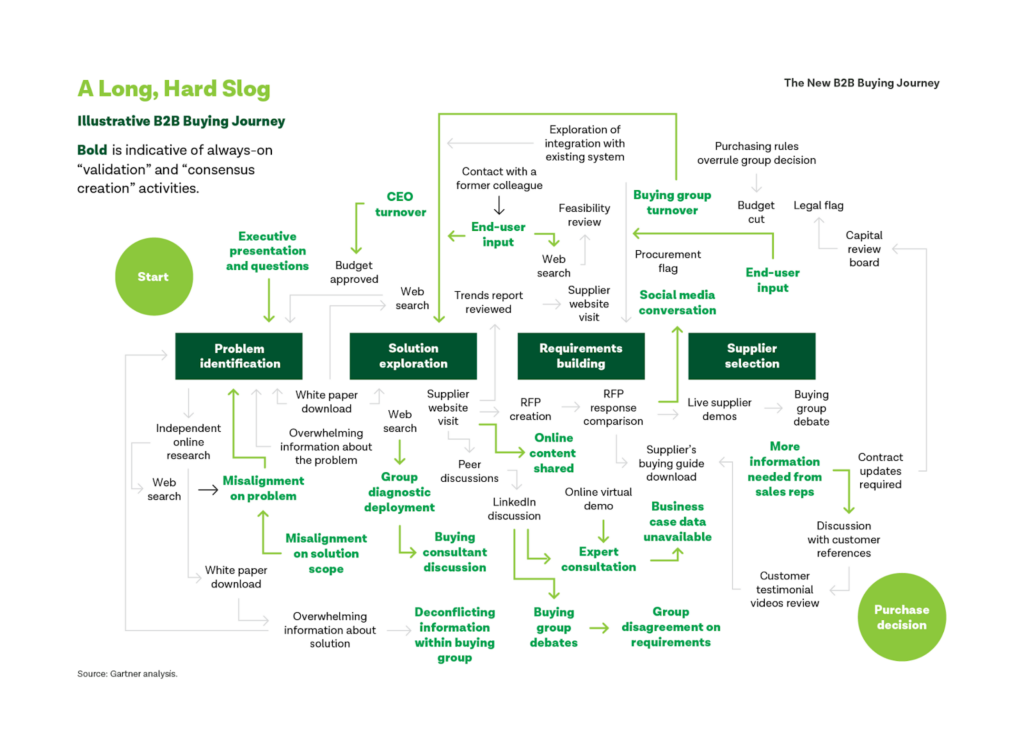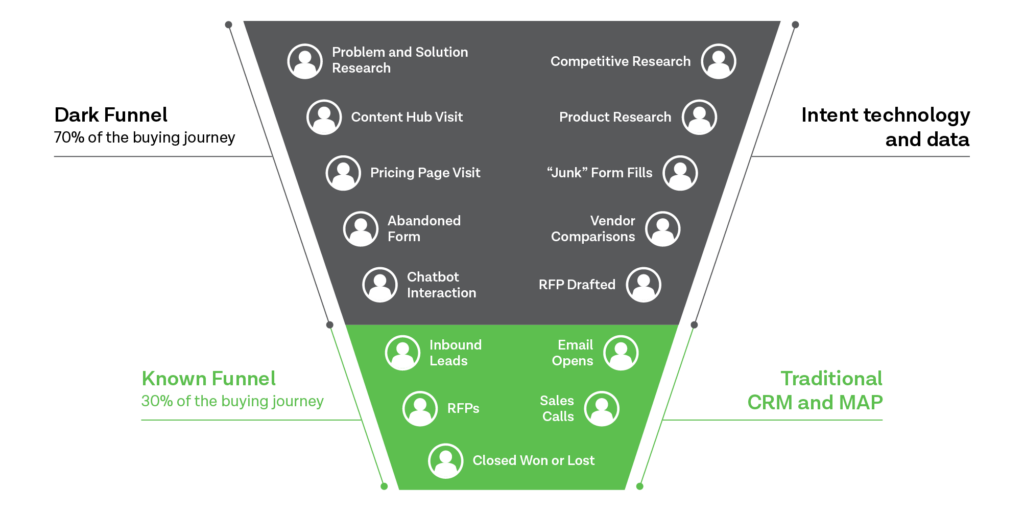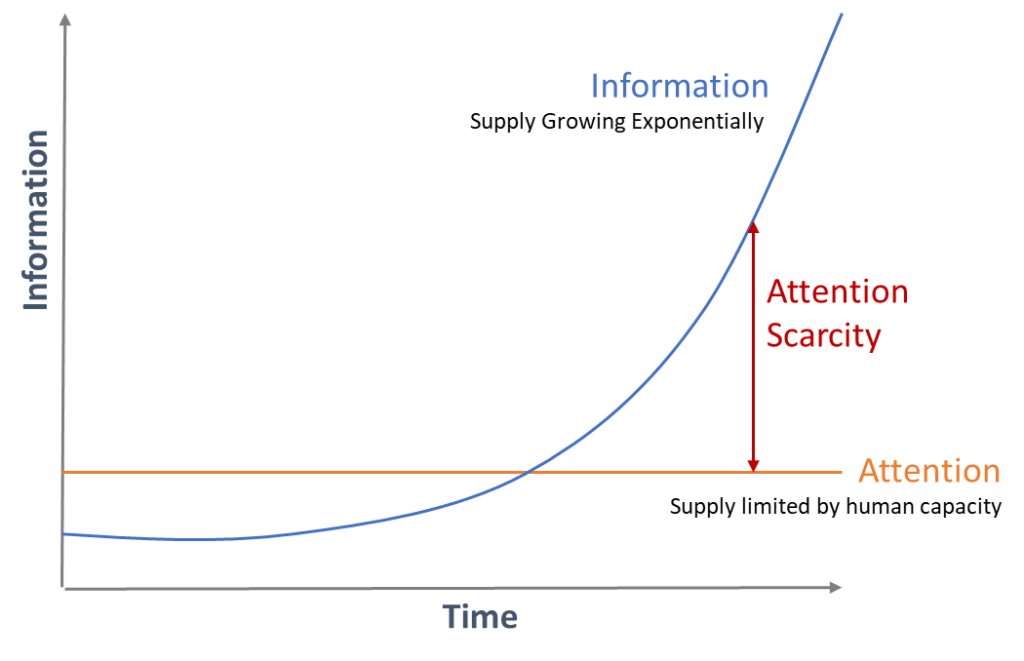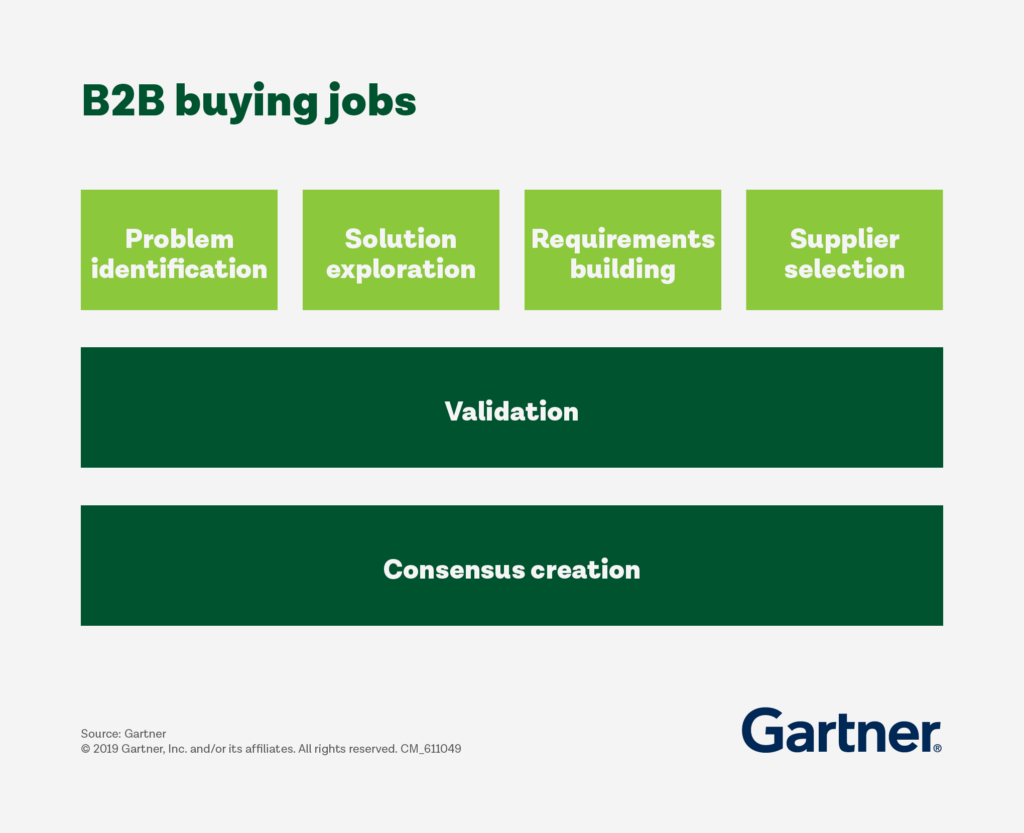Share

In a world of information excess and low trust, the B2B buying party is becoming harder and harder to engage.
According to Seth Godin, marketing guru and author of many best-selling books, including Purple Cow, Tribes, and This Is Marketing, “The two scarce elements of our economy are trust and attention.” This message rings loud and true for those in sales and marketing tasked with trying to engage busy executives to complete forms, attend events, or simply talk on the phone.
B2B sales and marketing is inherently complex, with buying cycles that stretch for months, even years, and a multitude of decision-makers and influencers involved along the way. The stakes are high, with big dollars and reputations on the line if things go awry.
Research by Green Hat and Gartner shows that the B2B buying party typically consists of between 6 and 10 people. This complexity is exponential, given each buying party member’s different roles, requirements, and priorities. We all know and understand the importance of strategic planning and thinking. However, real-world workloads, timelines, and resources often make this difficult.
In this article, I want to explain why it is essential to think strategically about this buying party and how this importance is intrinsically linked to account-centricity and genuinely empathising with the buying party to engage them effectively. This strategic approach needs to be underpinned by sales and marketing working as one team across the entirety of the buying journey.
I want to kick things off by discussing several macro trends. While these trends are not new, their impact on sales and marketing has been exponential, given the digital acceleration that has taken place over the last two and a half years.
These trends can be summarised as follows:
- the battle for the B2B buying party’s attention,
- the ever-diminishing role of sales influence on customer decisions, and
- a lack of trust and concerns about sharing personal data.
The battle for the B2B buying party’s attention
A war is raging for people’s attention, and the more influence the buying individual has, the more intense the battle. Rest assured, the members of your buying party will be the focus of many organisations, and you will need to compete for their attention.
Attention scarcity is a real thing. The concept was first derived from attention economy literature, which describes how the internet has changed how people acquire information and conduct business. Attention Scarcity refers to consumers being more selective with their attention than ever before, focusing on relevant stimuli while ignoring other stimuli from the environment.
Success in the attention economy is about maximisng the value of your audience’s attention by understanding what is important to them, when, and why. Not until you intimately understand your buyer’s world can you start planning how to engage with them.
Attention Scarcity of the B2B Buying Party. The human brain will respond to stimuli that are relevant and timely. If members of the buying party are ‘in-market’ for a particular B2B solution they will Be far more likely to engage.
The ever-diminishing role of traditional sales influence on customer decisions
Salespeople have fewer and fewer opportunities to influence customer decisions. The availability of quality information through different digital channels means potential customers can self-educate independently. This process of self-education, underpinned by a wariness to provide personal information in exchange for content out of fear of being inundated with unwanted emails or receiving a dreaded cold call, means buyers have formed strong views long before they talk to a supplier.
A confronting statistic by Gartner explains that buyers spend only 17 percent of their time with suppliers, well below the 27 percent of time spent researching independently or the 22 percent of time spent talking to the other members of the buying party. This is also a total number, so when considering time spent with each individual seller, this time allocation could be as low or lower than five percent.
A lack of trust and concerns about sharing personal data
Forrester’s 2021 Brand and Communications Survey discusses the B2B trust gap, which is the gulf between how B2B vendors rate trustworthiness and how customers rate them. This trust gap has never been wider. Forster goes on to reinforce the importance of trust and that it is the number one brand attribute for B2B Buyers.
Trust is critical for engaging the B2B buying party because of its intrinsic link to customer experience. In the Salesforce State of Marketing Insights report for 2022, the authors make a bold claim; Marketing is spelled D-A-T-A. This is for the simple fact that data is what enables a highly personalised, timely, and curated experiences. Trust is the fundamental tenant required for businesses to collect customer data, given the reluctance to share personal details and the inherent and growing conflict between personalised experiences and privacy regulations.
These three macro trends significantly impact how an organisation targets the buying party. Business is conducted in a digital-first world that has experienced many years of unexpected digital acceleration due to a two-year pandemic. A good question is how much has your organisation’s GTM changed over the past two years. The answer should be ‘significantly.’
A range of foundational elements must be covered to engage the buying party effectively. These include clarity on your ideal customer profile agreed between sales and marketing, in-depth knowledge of your buyer party personas, messaging architecture, content strategy, content map, etc. While I cannot over-emphasise the importance of these activities, they are table stakes and don’t need to be covered yet again.
A different perspective
In the context of a digital-first world, how do we think differently about engaging the buying party? I talked earlier about empathy and want to expand on this. An area that does not get enough focus is what all this means to the organisation and the people trying to make complex B2B buying decisions. The bottom line is that the process for buyers has become increasingly difficult.
Brent Adamson, distinguished VP of advisory at Gartner, sums up the above nicely “As hard as it has become to sell in today’s world, it has become that much more difficult to buy. The single biggest challenge of selling today is not selling, it is actually our customers’ struggle to buy.” A recent 2022 Harvard Business Review article provides some data behind the B2B buying party’s difficulty in making decisions. HBR’s large-scale study of more than two and a half million recorded sales conversations spanning both transactional and complex sales found that 40 percent and 60 percent of deals today are lost to customers’ inability to make a decision!
The way we think about engaging the buying party should be with the buyer front and centre. Members of the buying party do not delineate between sales, marketing or any other part of your organisation. What they are looking for is a seamless and consistent experience.
What does your organisation need to do to engage the buying party on their terms? How do you get as close as possible to the age-old marketing maxim of delivering the right message, to the right person, at the right time and in the right place?
A new way to engage the buying party
A few years ago, Gartner published what is, in my opinion, some of the most insightful research for sales and marketing in many years. The underlying narrative of this research highlights the complexity of the B2B buying process. To help buyers navigate through this complex purchase process, Gartner has identified six “Jobs” buyers must complete successfully to finalise a purchase.
Here is the Gartner research. The new B2B buyers’ journey.
This research also helped dispel any notion that the B2B buying party went through a nice clean linear path to purchase. Buyers engage in “looping,” revisiting each of those six buying jobs multiple times through the purchase process, this is more akin to a maze. This perspective highlights the importance of sales and marketing working together as one team to help customers move seamlessly from one buying job to another and back again. A team sports analogy is more appropriate than the traditional marketing-to-sales baton pass.
While the buying process is not linear, this does not mean a framework can’t be applied. Thankfully by mapping the non-linear account journey to a linear set of buying stages, we can measure progress and guide sales and marketing tactics to help complete the buying jobs. The critical thing to remember is to view engagement at an account level and understand that the account will move forwards and backward through the various stages. Your GTM and customer experience must be able to track and support the complexities of this process. Getting this right starts to negate the limited opportunities we have to influence the buying party in the digital-first world.

The function of the decision is increasingly complex, given that multiple decision-makers are required to complete multiple ’buying jobs’. These decisions then need to be validated, all while building consensus. Source: Gartner
Pulling it all together
Starting to plan your engagement with the buying party in terms of job completion can be an eye-opening experience when you begin to think about how to leverage your digital assets to guide accounts and the associated buying party through the buying process. When you map your content and activities against these buying jobs, you will get a feel for the completeness of your strategy and any potential gaps. In my role as Head of Account Based Experience at Green Hat and working through this process with different organisations, we often see gaps in high-value digital assets such as ROI calculators, benchmarks, and business case templates.
Once you have mapped your content assets against the 6 buying jobs and have carefully re-evaluated your gating strategy, think fewer forms and low friction, you are ready to start the actual targeting and engagement piece.
Mapping content to these buying jobs is a foundational element. However, remember that content consumption is the goal. Engagement tactics are needed to get the right message to the right person at the right time and in the right place.
Tech, data, and the ‘dark funnel.’
I have not spoken directly about technology and data’s role in enabling effective engagement with the B2B buying party. The long and short of it is that your ability to engage the buying party will be limited without specialised tech and data. The dark funnel is one of these limiting factors.
For those unfamiliar with the dark funnel, there’s no need to panic. This mysterious beast is not as sinister as it sounds. The dark funnel refers to all the anonymous research the buying party does to complete the required buying jobs. Think of it as an extension that sits on top of the traditional funnel but is ‘dark’ because conventional marketing tools can’t track these activities, so they are invisible or in the dark.
Using technology to illuminate the dark funnel provides visibility into which accounts and buying parties are researching what. These insights are then used to identify which accounts are actively somewhere in the purchase process for the types of products and services your organisation sells. We call these accounts ‘in-market.’
Focusing your efforts on these in-market accounts is critical in the pursuit of engaging the buying party because we now have relevance. The attention economy talks about the importance of relevance because people are more selective with their attention. In a world of information overload, we focus on relevant stimuli while ignoring all other environmental stimuli. If the buying party is in-market for your solutions, they will be much more open to your engagement tactics.

The ‘dark funnel’ – this is where most of the B2B buying party do anonymous research and form strong opinions and preferences.
That’s a wrap
B2B is complex and requires a strategic approach, and successfully engaging the buying party in a way that drives growth while simultaneously providing a great experience is no exception. Getting this right requires a systematic and disciplined approach.
As mentioned at the start of this discussion, there is an intrinsic link to strategically and collaboratively engaging the buying party and account-centric thinking. At Green Hat, we think about this account-centric process in five steps:
- Identify the right accounts and buying party members
- Craft your story for these accounts and buying parties
- Engage effectively through the buying journey
- Collaborate closely with sales to enable buyers to make decisions
- Measure what matters and optimise
Top and tail the above with goals and objectives (top) and building your tech and data (tail); you are on your way to more effective engagement in an increasingly complex buying process for buyers and sellers.
Scott Caulfield is the Head of ABM at Green Hat, Australia’s largest B2B agency.

















